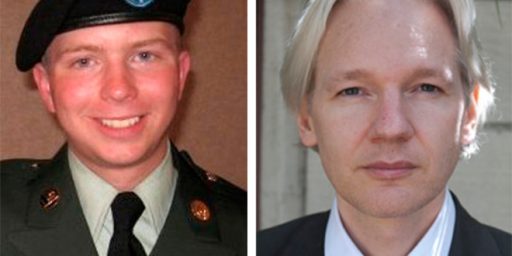FUTURE ARMY
Vernon Loeb explains how SECDEF Rumsfeld seems to be winning his battle with the Army brass to create a lighter, more flexible force. The most interesting aspects of the Rumsfeld direction are 1) the move away from the outmoded divisional structure to a more flexible task force orientation, 2) a radical overhaul of the current personnel management system, and 3) a realignment of the Guard and Reserves.
The move from divisions to “battle groups” only makes sense. While the giant 20,000-troop divisional structure made sense during WWII and throughout the Cold War, when war meant massing the entire military against a known enemy, it is very unwieldly when the force has to engage all manner of different enemies and missions across the spectrum of conflict. A smaller expeditionary unit, “task forces” in the Rumsfeld parlance, can be used in building block fashion as needed. We’ve fought our last several wars (at least Desert Storm and beyond) that way anyway, but it requires fashioning a headquarters element on the fly.
The current manning system is idiotic, designed almost solely for the purpose of managing the promotion system rather than encouraging unit cohesion and maximum readiness. Frankly, given the nature of the enemy we are likely to face, we can get away with a lot of inefficiency. I’m honestly not sure how the unit manning system described in this piece would work, unless it’s just going to be used at the company level and below. The Army had some success with the Cohort system in the 1980s but abandoned it for reasons that were never clear to me.
Finally, putting more of the heavy forces into the Reserve Component while dramatically increasing the civil affairs, psyop, military police, linguists, and other folks needed by the warrior-diplomat missions that we have engaged in for the past dozen years is just obvious. I’ve been arguing for that move since graduate school.






The Army should take a page from the Air Force’s Air Expeditionary Force structure which was utilized for the first major time in Iraq recently.
The amusing thing is that the Air Force copied that system from the Marine Corps. My guess is the Army will move in that direction as well, although they hate copying the Marines, whom they view as an unnecessary duplicate Army.
I for one, am very glad we have Rummy. He understands the modern enemy and he understands the modern battlefield.
[Not to pick on any one person but…]
I think if we went into this era with someone like William Cohen still at the helm it would have been a disaster.
The military had this overhaul coming for some time. I’m very glad someone competent was in the that chair when it was time to do it.
When you get a few minutes could you explain the “Cohort” system. I never heard of it.
I found a great discussion of it here. Basically, soldiers went to basic training and advanced individual training together and then shipped off to the same unit together and worked with a group of NCOs and officers who had likewise trained together. Then the unit would stay together for some time, maximizing cohesison. The problem was that COHORT was run as an experiment in small pockets and didn’t mesh with the wider system.
A discussion of the failures of the current system can be found here
If I understand your definition of the COHORT system, it sounds like what the original 101st airborne troops did in WWII. Having read “Band of Brothers” it seems that’s what Easy Company was and it was effective in terms of training and cohesiveness of the “team.”
—